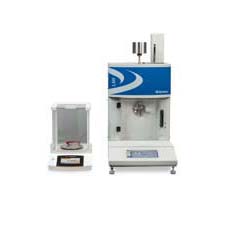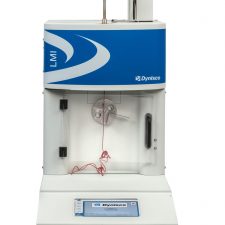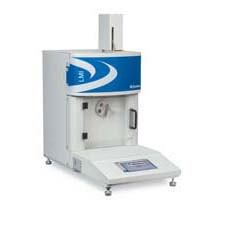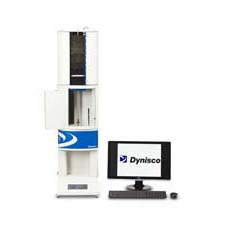LMI5000 Series
Setting the standard for accuracy and reliability when evaluating polymer melt flow characteristics. With the LMI5000 melt flow indexer, get quick and accurate measurement of melt flow characteristics to determine material quality, lot to lot consistency, and ensure what you are buying is in fact what you need.
- NEW! Automatic Sample Cutter (Autocutter) for ease and consistency in sample cutting. Benefits include:
- It keeps users away from hot barrel when retrieving samples
- Increased repeatability of sample size
- Increased automation with the ability to run more than one LMI at a time
- Easy retrofit into existing machines
- Performance meets international standards: A2LA Accreditation, ASTM D1238 & D3364, ISO 1133, BS2782, DIN 53735 JIS K7210
- Color Touch Screen with a simplified, user-friendly interface for setup and control
- Semi-automated pneumatic weight lift option for all weight loads
- Ergonomic, stackable weights from .325 – 31.6kg for all LMI applications
- Force Packer option for consistent material packing
- USB connectivity for data storage, scale integration, networking and printing capabilities
- Melt Flow Rate to Intrinsic Viscosity correlation for PET
- 100 program storage capability when used with software option
- Modular options allow for easy field upgrades from a base model to a fully integrated Analyzer vs. Instrument
Collateral
Applications for Capillary Rheometers
From breakthrough technology in the industry’s most complete line of sensors to renowned quality and performance in indicators, controls, and analytical instruments Dynisco has demonstrated the skill, experience and know-how that not only deliver the right solution for your unique application, but also provide unparalleled customer support.
Datasheets
Podcasts
How Dynisco is Remolding the Plastics Industry Podcast
In this episode, Microsoft’s podcast hosts Deb Oberly and Dani Diaz talk with John Biagioni, President of Dynisco, who is bringing our vision of “rheology to the masses” to fruition with trailblazing cloud solutions for the plastics industry. Learn about the details of our industry and company, the surprises and insights of our journey crafting their IoT solutions, the immense value of the data we are collecting and our deliberate approach for continued success in this space.
Product Videos
Dynisco IoT Cloud Connect: There For You 24/7 When You Can’t Be
We are living in rapidly changing times. The entire world is working differently then we ever have in the history of manufacturing. Learn how the Dynisco IoT Cloud Connect can help processors manage and monitor their production lines remotely
LMI Melt Flow Indexer
Relevant Articles
Melt Flow Testing Article Part 1
Though often criticized, MFR is a very good gauge of the relative average molecular weight of the polymer. Since molecular weight (MW) is the driving force behind performance in polymers, it turns out to be a very useful number.
Melt Flow Testing Article Part 2
To fully appreciate the strengths and weaknesses of the melt-flow-rate (MFR) test it is important to know something about the way the test is performed.
Melt Flow Testing Article Part 3
There is a well-established relationship between something called the weight average molecular weight of a polymer and a parameter known as the zero-shear viscosity.
Melt Flow Testing Article Part 4
Few molders perform the test in-house. Of those that do, most don’t understand why they are doing it or what they are measuring.
Melt Flow Testing Article Part 5
There are two points in the manufacturing supply chain where a determination of average molecular weight (MW) is important. The first is when the material is first received by the molder. The second is after molding.
Melt Flow Testing Article Part 6
Once degradation has been established, the discussion inevitably turns to how it happened. It might be expected that the answer to this question is widely known. Not so. The good news is that the influences that cause polymer degradation during processing are few.
Melt Flow Testing Article Part 7
Here is why the melt flow test is not universal. As useful as the melt flow rate (MFR) test can be, it is not universally applicable. Fundamentally, the test is intended to document differences in molecular weight.
Melt Flow Testing Article Part 8
Here are the steps to take in cases where the MFR is not provided by the polymer supplier. The number of commercial materials that employ a melt flow rate (MFR) value as part of the published property profile attests tO the usefulness of the test.
Melt Flow Testing Article Part 9
Understanding the value of melt-volume rate. If you spend a lot of time looking at data sheets you have probably noticed a trend over the last several years in how the melt flow rate (MFR) is reported. Along with, or instead of, the MFR, a new line item is appearing called the melt volume rate (MVR).
Webinars
Simplified Rheology for the Masses
We address issues such as the need to test polymers, the correlation of lab values to online production, and the impact of melt flow index and viscosity on part quality and profitability.
Simplified Rheology: A Technical Discussion
Understand technical aspects of how parameters change between laboratory standards and production and how advanced equipment today can adjust for these differences.
Tech Notes
Detecting Polymers in Material Products
It can be very difficult, if not impossible, to achieve complete indentification of most polymer products. However, in most cases, this is usually not needed; what is needed is the separation, or identification, of numerous molding materials whose identity has been lost, or an indication of the type of material used to create a component.
The LaVA Suite software for the new LMI5000 series has the look and feel of applications for the latest PCs or mobile devices. Screen layout and menu navigation is immediately intuitive to lab personnel of every skill level.
No longer are large, heavy weights needed to achieve all of the ASTM D1238 testing conditions. Operators will now be able to stack combinations of smaller, easier to handle weights to attain the desired overall weight. With the introduction of these new weights, we are also introducing a new, easier to understand part number system. Please use this document as a guide to the new part numbers as well as for suggestions on how to achieve the ASTM D1238 weight values.




